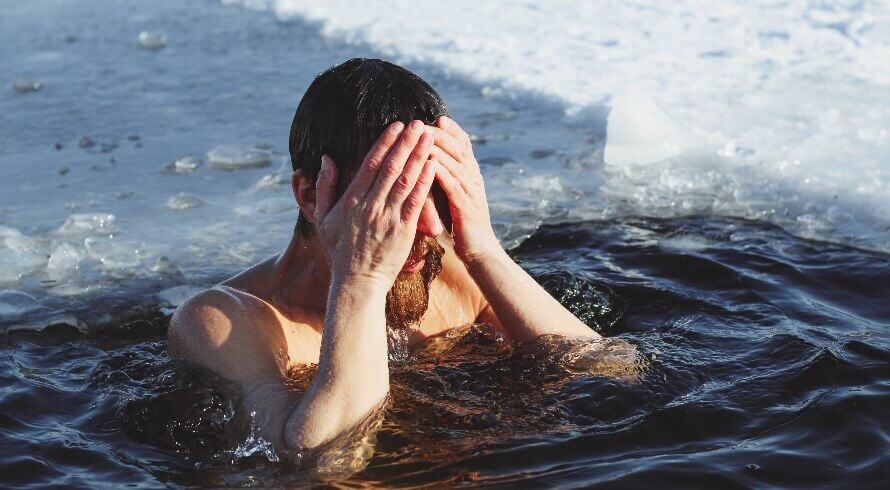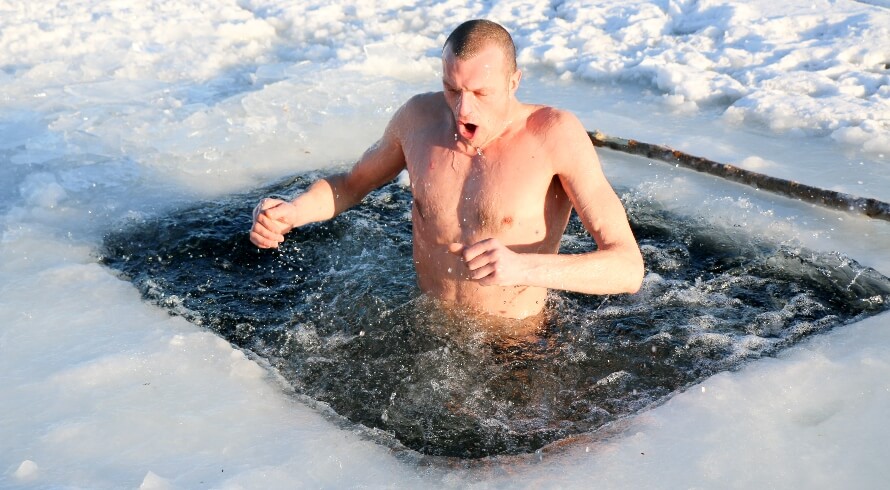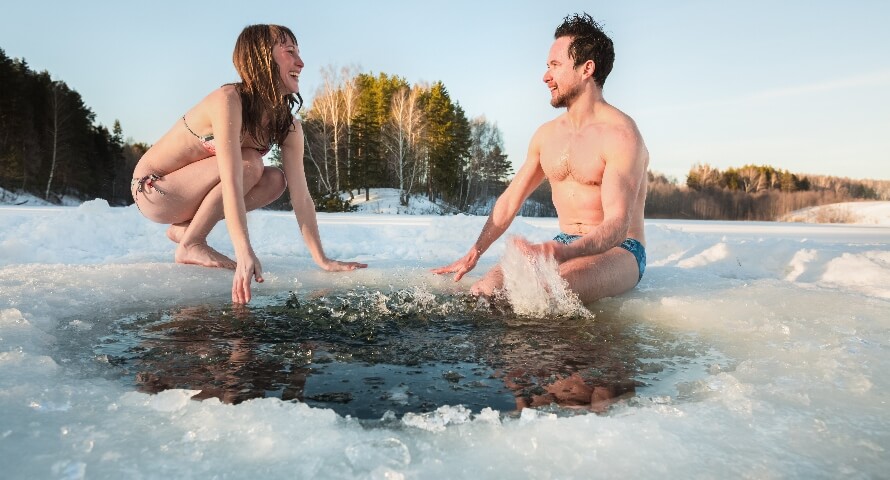In accordance with most well being, health, and biohacking “gurus,” taking an ice tub earlier than or after a exercise is the key to sooner restoration, sharper focus, and higher efficiency.
Heck, even some scientists-cum-podcasters say so, too.
Whereas this makes for a compelling spiel, scientific proof doesn’t essentially agree.
In reality, most analysis suggests utilizing a chilly plunge earlier than or after a exercise can truly make it more durable to construct muscle and achieve power.
On this article, you’ll discover out why that is, uncover the greatest time to chilly plunge to keep away from these points, and extra.
Key Takeaways
Chilly plunging, or “chilly water immersion,” is the follow of immersing your self as much as your shoulders in chilly water for a brief interval.
Not too long ago, it has develop into standard to chilly plunge earlier than or after a exercise as a result of some consider it sharpens focus, boosts testosterone and power manufacturing, and accelerates restoration.
Most analysis suggests taking a chilly plunge earlier than or after a exercise can harm your capacity to construct muscle and achieve power.
Chilly plunging earlier than a exercise would possibly make you’re feeling extra alert, however it may well decrease muscle temperature, scale back power, and hinder efficiency.
An ice tub after a exercise might scale back soreness, however it may well additionally intervene with the muscle progress wanted for constructing dimension and power.
The greatest time to chilly plunge isn’t earlier than or after a exercise—do it on relaxation days to keep away from disrupting your progress.
What Is a Chilly Plunge?

Chilly plunging, or “chilly water immersion,” is the follow of immersing your self as much as your shoulders in chilly water for a brief interval. Folks have practiced chilly plunging for hundreds of years, utilizing it as a solution to recuperate from intense bodily exercise, scale back fatigue, and alleviate muscle soreness.
Chilly plunging has not too long ago surged in reputation, with well being and health thought leaders endorsing it as a solution to improve psychological readability, speed up restoration, and enhance general wellness.
Ought to You Chilly Plunge Earlier than a Exercise?
Is leaping right into a chilly plunge pre-workout a sensible transfer?
Right here’s what science says concerning the professionals and cons of chilly plunging earlier than your exercise.
Advantages of Chilly Plunging Earlier than a Exercise
The shock of getting into chilly water triggers the discharge of neurotransmitters reminiscent of serotonin, cortisol, dopamine, norepinephrine, and beta-endorphin, which might enhance alertness and sharpen focus.
Advocates of taking a chilly plunge pre-workout argue this can assist you keep dialed in throughout coaching and push by way of difficult exercises with extra depth.
A number of research additionally present that “pre-cooling” (taking an ice tub or chilly bathe earlier than a exercise) might make endurance train within the warmth really feel much less fatiguing and, thus, extra manageable.
Whereas fascinating, there’s no proof you get the identical advantages of chilly plunging earlier than a exercise involving resistance coaching, particularly in an air-conditioned fitness center.
One other widespread claimed advantage of taking a chilly plunge earlier than a exercise is that it boosts testosterone. Though these claims aren’t completely baseless—some analysis suggests excessive chilly publicity might improve “T” to a point—the proof isn’t very convincing.
Take, for instance, a examine carried out by the College of Canberra that many cite as “proof” chilly plunging earlier than train boosts testosterone.
The examine had rugby gamers use cryotherapy earlier than coaching, and whereas some confirmed a rise in T, the findings had been flimsy at greatest.
First, it included solely 12 males, and never all of them noticed a rise. Second, it used cryotherapy at -220°F, which is way colder than a typical chilly plunge at 60°F. Third, it measured testosterone ranges at totally different instances of the day for various individuals with out accounting for pure every day fluctuations.
Lastly, it solely tracked testosterone ranges for 3 hours after the exercise. Whereas some males did see a short-term spike, this type of temporary improve is unlikely to have any significant long-term impact on muscle progress.
Testosterone isn’t the one buzzword thrown round in terms of chilly plunging. The promise of elevated “mitochondrial density” is one other standard promoting level.
The professional-cold-plunge crowd argue that pre-workout chilly publicity boosts the variety of mitochondria in brown fats and muscle cells, which may improve your physique’s capacity to provide power and, subsequently, enhance athletic efficiency.
Whereas this idea sounds intriguing, present proof solely comes from research on rodents. Till human research again these claims, it’s wise to remain skeptical.
Drawbacks of Chilly Plunging Earlier than a Exercise
Chilly plunging earlier than a exercise has clear downsides.
First, analysis exhibits that as muscle temperature drops, so does its capacity to generate pressure.
One examine discovered {that a} lower of simply 1.8°F in muscle temperature prompted a 4.2% decline in energy, whereas one other examine discovered that cooling muscular tissues to 84°F lowered peak pressure manufacturing by as much as 21%.
The takeaway: chilly muscular tissues merely don’t carry out in addition to heat ones, so in case your exercise entails heavy lifting or explosive actions, taking a chilly plunge earlier than your exercise may harm your efficiency.
Chilly publicity additionally slows nerve conduction (how electrical alerts journey alongside nerves), which might have an effect on coordination, response instances, handbook dexterity, and motion effectivity. In different phrases, taking an ice tub earlier than your exercise may make performing complicated workouts like squats, deadlifts, presses, and pull-ups more difficult.
And when workouts are tough to carry out, you’ll carry much less weight for fewer reps, which can hamper your capacity to realize muscle and power over time.
Then there’s the affect on steadiness. Chilly publicity can hinder steadiness whether or not you’re standing nonetheless or shifting in a number of instructions. Thus, taking a chilly plunge earlier than your exercise would possibly make it more durable to stabilize your physique throughout workouts that require steadiness and coordination like Bulgarian cut up squats or lunges.
Ought to You Chilly Plunge After a Exercise?


Many assume the greatest time to chilly plunge is after you’ve labored out. The idea goes that doing so promotes fast restoration and reduces soreness.
Is that this true?
Listed here are the professionals and cons of taking a chilly plunge after a exercise.
Advantages of Chilly Plunging After a Exercise
Analysis exhibits that chilly plunging after a exercise can scale back delayed onset muscle soreness (DOMS), decrease blood markers of muscle injury and irritation, scale back swelling, assist clear waste merchandise out of your muscular tissues, and make you’re feeling much less drained.
For these causes, it may be good for restoration.
The one caveat is that whereas chilly plunging after your exercise could make you’re feeling higher, it doesn’t all the time translate to raised efficiency.
In different phrases, it could soothe your sore muscular tissues, nevertheless it gained’t essentially assist you recuperate your power sooner. And if a restoration modality doesn’t will let you prepare more durable sooner, it’s most likely not an amazing use of time.
That doesn’t imply you shouldn’t give chilly plunging a shot—it could be value making an attempt to see the way it impacts your restoration. However focus much less on the way it makes you’re feeling and extra on whether or not it helps you recoup your power sooner.
If it makes you’re feeling higher and helps you regain your power extra rapidly, hold it in your routine. But when it solely reduces soreness with out enhancing your efficiency, you would possibly get extra profit from different restoration modalities (like supplementing intelligently or sleeping extra).
Drawbacks of Chilly Plunging After a Exercise
In case your essential purpose is to construct muscle, taking a chilly plunge after your exercises is probably not the very best concept.
A 2019 examine carried out by Deakin College discovered that individuals who took an ice tub after their exercises gained much less muscle than those that didn’t. Two different research discovered related outcomes.
Why does chilly water immersion scale back muscle progress?
Scientists consider it disrupts the molecular pathways—chains of chemical reactions within the physique—that drive muscle progress. As an illustration, ice baths decrease the blood ranges of proteins that assist construct muscle and improve the degrees of proteins that break it down.
Chilly plunging additionally cools your muscular tissues, which hinders the enzymes that restore and develop muscle and reduces blood move—each of that are essential for muscle progress.
When Is the Greatest Time to Chilly Plunge?


In case your purpose is to construct muscle and achieve power, don’t chilly plunge earlier than or after your exercises.
Chilly plunging earlier than lifting weights would possibly make you’re feeling extra alert, however it would possible hinder your efficiency, making it more durable to realize dimension and power.
Chilly plunging after power coaching can even instantly restrict muscle progress, so it’s not a sensible transfer both.
The greatest time to chilly plunge is on relaxation days, ideally as far out of your final exercise as potential. For instance, for those who prepare on Monday morning, wait till Tuesday night or Wednesday to take an ice tub.
This reduces the possibility that your chilly plunge will disrupt the bodily processes concerned in muscle progress.
FAQ #1: How lengthy must you chilly plunge earlier than a exercise?
Typically talking, utilizing a chilly plunge earlier than a exercise isn’t a good suggestion, particularly in case your purpose is to construct muscle or achieve power. Chilly publicity reduces the temperature of your muscular tissues, decreases how a lot pressure you may produce, and hinders coordination, all of which might hamper efficiency.
If you wish to chilly plunge pre-workout to assist with endurance within the warmth, analysis suggests 2-to-4 minutes is lengthy sufficient to get advantages with out experiencing drawbacks.
FAQ #2: What are the advantages of chilly plunging?
Chilly plunging can present a number of advantages, relying on when and the way you employ it.
If you happen to chilly plunge earlier than a exercise, it could improve alertness and focus by triggering a launch of neurotransmitters like dopamine and norepinephrine. It could actually additionally assist with endurance train in sizzling situations by reducing your core physique temperature, making the warmth really feel much less fatiguing.
If you happen to chilly plunge after a exercise, it may well scale back DOMS, decrease irritation, scale back swelling, and assist clear waste merchandise out of your muscular tissues. These results could make you’re feeling much less drained and extra recovered.
Nevertheless, in case your essential purpose is to construct muscle or achieve power, chilly plunging earlier than or after a exercise is probably not excellent, as it may well hinder efficiency and muscle progress.
FAQ #3: How lengthy ought to I chilly plunge for the advantages?
If you happen to chilly plunge after a exercise to scale back DOMS, analysis suggests bathing in 52-to-59-degree water for 11-to-Quarter-hour is perfect.
If you happen to chilly plunge earlier than an endurance exercise within the warmth, bathe for round 2-to-4 minutes.
Scientific References +
Allan, Robert, et al. “Chilly for Centuries: A Temporary Historical past of Cryotherapies to Enhance Well being, Damage and Submit-Train Restoration.” European Journal of Utilized Physiology, vol. 122, no. 5, 23 Feb. 2022, hyperlink.springer.com/article/10.1007/s00421-022-04915-5,
Kelly, John S., and Ellis Fowl. “Improved Temper Following a Single Immersion in Chilly Water.” Way of life Medication, vol. 3, no. 1, 2 Dec. 2021, onlinelibrary.wiley.com/doi/full/10.1002/lim2.53,
Yankouskaya, Ala, et al. “Brief-Time period Head-out Entire-Physique Chilly-Water Immersion Facilitates Constructive Have an effect on and Will increase Interplay between Massive-Scale Mind Networks.” Biology, vol. 12, no. 2, 29 Jan. 2023, p. 211,
Choo, Hui C., et al. “Ergogenic Results of Precooling with Chilly Water Immersion and Ice Ingestion: A Meta-Evaluation.” European Journal of Sport Science, vol. 18, no. 2, 26 Nov. 2017, pp. 170–181, Accessed 28 Jan. 2020.
Bongers, Coen C. W. G., et al. “Cooling Interventions for Athletes: An Overview of Effectiveness, Physiological Mechanisms, and Sensible Issues.” Temperature, vol. 4, no. 1, 3 Jan. 2017, pp. 60–78, www.ncbi.nlm.nih.gov/pmc/articles/PMC5356217/,
Russell, M., et al. “The Results of a Single Entire Physique Cryotherapy Publicity on Physiological, Efficiency and Perceptual Responses of Skilled Academy Soccer Gamers Following Repeated Dash Train.” Journal of Energy and Conditioning Analysis, vol. 31, no. 2, Might 2016, p. 1,
M. Partridge, Emily, et al. “Utility of Acute Pre-Train Partial-Physique Cryotherapy Promotes Soar Efficiency, Salivary-Amylase and Athlete Readiness.” Biology of Sport, 2022, Accessed 28 Oct. 2021.
Qiu, Jiamin, et al. “FAM210A Is Important for Chilly-Induced Mitochondrial Transforming in Brown Adipocytes.” Nature Communications, vol. 14, no. 1, 10 Oct. 2023, Accessed 7 Apr. 2024.
Chung, Nana, et al. “The Results of Train and Chilly Publicity on Mitochondrial Biogenesis in Skeletal Muscle and White Adipose Tissue.” Journal of Train Vitamin & Biochemistry, vol. 21, no. 2, 30 June 2017, pp. 39–47, www.ncbi.nlm.nih.gov/pmc/articles/PMC5545200/, Accessed 8 Feb. 2023.
Davies, C. T., and Okay. Younger. “Impact of Temperature on the Contractile Properties and Muscle Energy of Triceps Surae in People.” Journal of Utilized Physiology, vol. 55, no. 1, 1 July 1983, pp. 191–195, Accessed 13 Oct. 2020.
Cross, Kevin M., et al. “Practical Efficiency Following an Ice Immersion to the Decrease Extremity.” Journal of Athletic Coaching, vol. 31, no. 2, 1996, pp. 113–116, www.ncbi.nlm.nih.gov/pmc/articles/PMC1318440/.
Fischer, Jennifer, et al. “Practical Efficiency Following an Ice Bag Utility to the Hamstrings.” Journal of Energy and Conditioning Analysis, vol. 23, no. 1, Jan. 2009, pp. 44–50, Accessed 27 Aug. 2019.
Didehdar, Daryoush, and Sobhan Sobhani. “The Impact of Chilly-Water Immersion on Bodily Efficiency.” Journal of Bodywork and Motion Therapies, vol. 23, no. 2, Apr. 2019, pp. 258–261,
Bergh, U, and B Ekblom. “Affect of Muscle Temperature on Maximal Muscle Energy and Energy Output in Human Skeletal Muscle tissue.” Acta Physiologica Scandinavica, vol. 107, no. 1, 1979, pp. 33–7, www.ncbi.nlm.nih.gov/pubmed/525366,
Sargeant, Anthony J. “Impact of Muscle Temperature on Leg Extension Pressure and Brief-Time period Energy Output in People.” European Journal of Utilized Physiology and Occupational Physiology, vol. 56, no. 6, Sept. 1987, pp. 693–698,
Herrera, Esperanza, et al. “Motor and Sensory Nerve Conduction Are Affected Otherwise by Ice Pack, Ice Therapeutic massage, and Chilly Water Immersion.” Bodily Remedy, vol. 90, no. 4, 1 Apr. 2010, pp. 581–591,
Cheung, Stephen S., et al. “Adjustments in Handbook Dexterity Following Brief-Time period Hand and Forearm Immersion in 10 Levels c Water.” Aviation, House, and Environmental Medication, vol. 74, no. 9, 1 Sept. 2003, pp. 990–993, pubmed.ncbi.nlm.nih.gov/14503680/. Accessed 11 Sept. 2022.
Mäkinen TM;Rintamäki H;Korpelainen JT;Kampman V;Pääkkönen T;Oksa J;Palinkas LA;Leppäluoto J;Hassi J. “Postural Sway throughout Single and Repeated Chilly Exposures.” Aviation, House, and Environmental Medication, vol. 76, no. 10, 2024, pubmed.ncbi.nlm.nih.gov/16235878/. Accessed 16 Sept. 2024.
MONTGOMERY, ROGER E., et al. “Impact of Segmental, Localized Decrease Limb Cooling on Dynamic Steadiness.” Medication & Science in Sports activities & Train, vol. 47, no. 1, Jan. 2015, pp. 66–73, Accessed 7 Jan. 2020.
Dupuy, Olivier , et al. An Proof-Primarily based Method for Selecting Submit-Train Restoration Methods to Cut back Markers of Muscle Harm, Soreness, Fatigue, and Irritation: A Systematic Evaluate with Meta-Evaluation. 28 Apr. 2018,
Angelopoulos, Pavlos, et al. “Chilly-Water Immersion and Sports activities Therapeutic massage Can Enhance Ache Sensation however Not Performance in Athletes with Delayed Onset Muscle Soreness.” Healthcare, vol. 10, no. 12, 5 Dec. 2022, p. 2449, Accessed 10 Dec. 2022.
Fyfe, Jackson J., et al. “Chilly Water Immersion Attenuates Anabolic Signaling and Skeletal Muscle Fiber Hypertrophy, however Not Energy Achieve, Following Entire-Physique Resistance Coaching.” Journal of Utilized Physiology, vol. 127, no. 5, 1 Nov. 2019, pp. 1403–1418,
Roberts, Llion A., et al. “Submit-Train Chilly Water Immersion Attenuates Acute Anabolic Signalling and Lengthy-Time period Diversifications in Muscle to Energy Coaching.” The Journal of Physiology, vol. 593, no. 18, 13 Aug. 2015, pp. 4285–4301,
Yamane, M., et al. “Does Common Submit-Train Chilly Utility Attenuate Skilled Muscle Adaptation?” Worldwide Journal of Sports activities Medication, vol. 36, no. 08, 11 Mar. 2015, pp. 647–653, Accessed 12 Sept. 2019.
Source link



